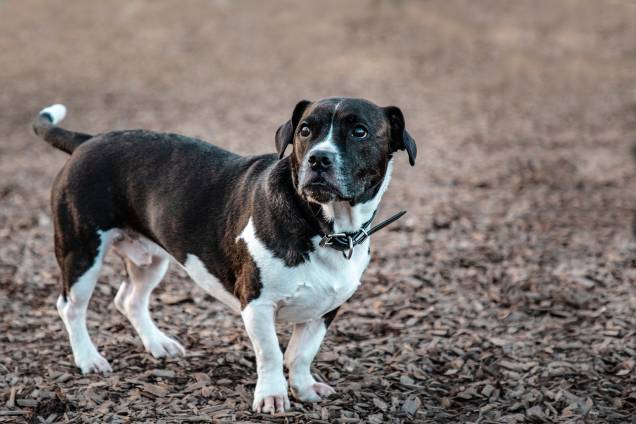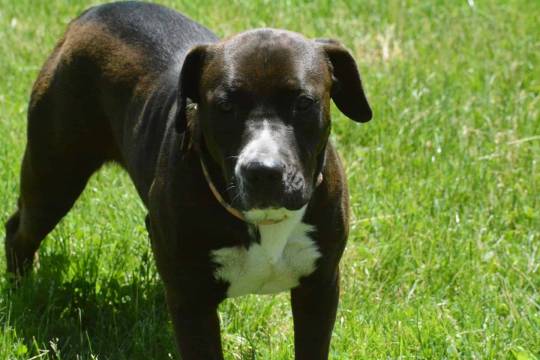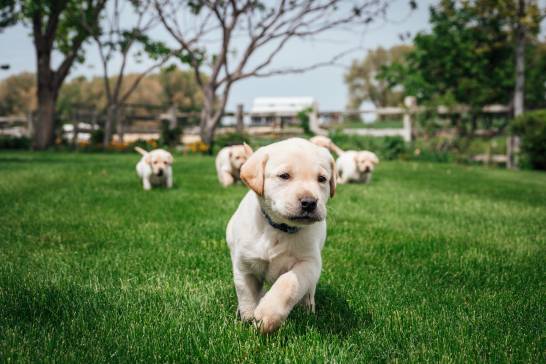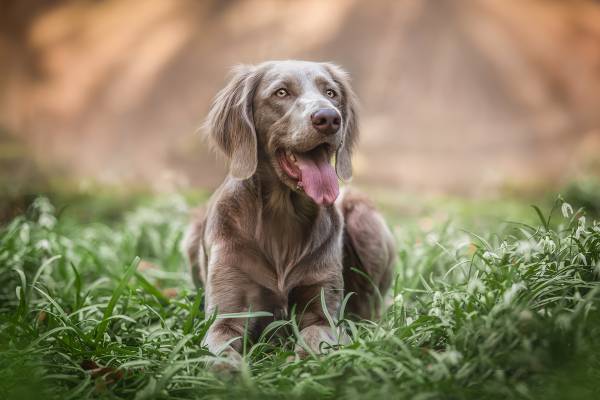Connect with a verified veterinarian in minutes. Licensed vets are available 24/7 to answer your questions. No need to worry about your furry family member.
Are you searching for the right dog breed to have as a family companion? Maybe you’re not sure what type of dog is best for you. If so, then you’ve come to the right place.
We’ve put together information about the Pugador! This may be a dog breed you’re not heard of, but we’ve gathered information to create a guide with what you need to know about these dogs. Let’s get started!
What is a Pugador?
The Pugabor is an adorable hybrid dog breed, a cross between a purebred Pug and a purebred Labrador Retriever. This may sound like a strange mix for a dog; however, the Pug Lab mix is truly cute! This relatively new dog breed is called the Pugador.
No one is certain about the Pugador’s history. The only thing we know for sure is that these are “designer dogs,” which may have first been bred sometime in the 1990s. During that time, breeders were experimenting with breeding different purebred dogs together. One of their goals was to create healthier dogs without the health issues of the purebred parents.
While we don’t know much about the Pugador’s history, we do have more information about the breed’s purebred parents!
The Labrador Retriever comes from an island just off Newfoundland, on Canada’s Atlantic coast. The first record of these dogs comes from the 1700s. Labs were first bred to help fishermen mind the nets, catch stray fish, and more. However, today these dogs perform other duties and are wonderful family companions.
Labs have an athletic, muscular build and short coats. They’re highly intelligent dogs and have a ton of energy. If you’ve ever played with a Labrador Retriever, you may understand what we mean! The Lab will play until you can’t play anymore, still expecting you to play with him!
Because they have so much energy, these dogs often work as assistance dogs, search & rescue dogs, and more. In addition, Labs excel at most dog sports, including agility, obedience, swimming, and other types of competitions.
Now, let’s take a look at the other purebred parent of the Pugador—the Pug! The Pug dates all the way back to ancient China (206 BC to 200 AD). The dogs were companions to Emperors and lived luxurious lives. They were so valuable that guards were used to protect these beloved dogs.
Pugs are cute and somewhat comical. Their face is sweet and has deep wrinkles, with large, dark eyes. Their face is a bit flat and round. These are playful dogs who love games and having fun! However, they also love their humans and need to be close to them most of the time. These small dogs love to be the center of attention and don’t do well when left alone for long periods.
Pugs have square, thick, muscular bodies. Their face may also have a black mask. These dogs, like Bulldogs, have a jaw that sticks out a little further than the lower jaw. So, their bottom teeth may be visible.
So, these are the purebred parents of the Pugador! But what does a Pugador look like with such different parents?
Pugador Appearance
Pugs and Labradors are quite different dogs, so you may well wonder what their puppies look like! However, it’s essential to remember Pugadors are hybrid dogs. This means they inherit genes from both of their purebred parents. Most people believe a hybrid dog is a 50/50 mix of its parents; however, that’s not the case.
A hybrid dog randomly inherits genes from both parents. This may mean the Pugador is more like the Lab parent or the Pub parent, depending on his genes. What’s more, even puppies in the same litter may look different! It’s possible to have one puppy that strongly resembles the Pug parent and another puppy that looks more like a Lab. Then there could even be puppies somewhere in the middle; however, none of them is a 50/50 mix of the parents.
What does this mean for Pugadors? There’s no standard appearance for this dog breed. They come in various colors and sizes. They may come in colors of white, black, tan, or brown. And they may have a thick, straight, double coat that sheds quite a bit. These dogs may also love water, like their Lab parent, and be more on the athletic side. However, they may also take after their Pub parent and not be quite so active!
Pugadors can have eyes that are hazel, brown, or amber and a black or brown nose. Their eyes may also be slightly bulgy like a Pug’s. The dogs may also have a shorter muzzle and stocky build but have longer legs (than a Pug’s), along with a long, curling tail. And when it comes to size, these dogs usually stand between 15 to 20 inches tall and weigh between 30 to 59 lbs.

Review symptoms, medications & behavior to keep your pets healthy with a Vet Online in just minutes.
Ask a Vet Live NowPugador Temperament & Personality
As you can imagine, with two such friendly, loving parents, the Pugador is also very friendly and loving. They’re also great with kids and make wonderful family companions.
These dogs love to play and stay connected with their family. For this reason, Pugadors are prone to developing separation anxiety if left alone for long periods. The best families for these dogs are those that have time to be with these charming fur babies most of the time.
One thing these dogs get from their Pug parents is some stubbornness. They’re intelligent dogs, but sometimes they want to have their own way! For this reason, the dogs need to be trained and socialized from a young age. In addition, these dogs tend to be very loyal to their loved ones.
Pugadors also tend to get along well with other dogs and pets. However, these dogs must be trained and socialized from a young age to ensure they get along with other dogs and small pets.
Pugador Health Issues
Pugadors are usually very healthy dogs; however, they can be susceptible to the health issues of both parents. Pugadors may develop the following health issues:
- Breathing difficulties (in dogs that have a shorter muzzle, like their Pug parent)
- Heat stroke (mostly during exercise)
- Dental problems
- Heart problems
- Ear infections
- Elbow dysplasia
- Obesity
- Damage to the surface of their eyes
- Allergies & eczema
- Bacterial and fungal infections in their wrinkles & under their tail
- High risk of problematic births
- Deformed vertebrae
Pugadors have a life expectancy between 11-13 years.
One of the best ways to keep your Pugador healthy is to take him to the vet for regular checkups. Regular checkups give the vet a chance to catch health issues early before they become serious problems. Most conditions, when caught early, are easier to treat and cure. And it’s critical to ensure your dog also has all of his required vaccinations.
In addition, you may want to consider purchasing pet health insurance. Many policies on the market provide cover health conditions, accidents, vaccinations, checkups, and more.
Pugador Care
When it comes to their coat, the Pugador does tend to shed, like his purebred parents. However, Labs do tend to shed more than Pugs, so it’s hard to say whether the Pugador may be more like their Lab or Pug parent.
No matter how much the dog sheds, Pugadors benefit from regular brushing. This makes their coat shiny and healthy, while it also controls the amount of shed fur all over your home. If you brush your fur baby regularly, then there’s less fur to vacuum and clean up later.
These dogs also benefit from bathing once a month or more if they become dirty and smelly.
Another issue with Pugadors is if they have a wrinkled face like their Pug parent. If so, Pugadors require their wrinkles to be cleaned and dried regularly. This helps to keep the area from developing fungal or bacterial infections caused by moisture that stays in the wrinkles.
Pugador Exercise Requirements
While the Lab parent is highly active, the Pug isn’t. So, the Pugador is somewhere in the middle. Most Pugadors require moderate amounts of exercise. They need about 50 minutes of exercise a day, which may be divided between a morning and evening walk.
And, of course, the Pugador likes to play! So, make sure you spend time playing with this adorable canine companion. These dogs need the mental stimulation that playing provides. They love interactive dog toys, running in the yard, and more.
Another note on Pugadors and exercise; if your Pugador strongly resembles his Pug parent, make sure to avoid over-exercising these dogs or exercising them on warm, humid days. Pugadors that have the “squished” face of their Pug parent have a hard time breathing, and this becomes worse when overheating or over-exercising. They are also prone to developing heat stroke. So, you may want to exercise your Pugador shortly during the coolest parts of the day.
Training a Pugador
Pugadors are highly intelligent like their Lab parents! However, they can also be stubborn, like their Pug parents. So, you can expect the Pugador to be intelligent and want to do things his way. That’s OK! With positive enforcement training methods and socialization, these dogs will take to training quite well.
Pugadors, like other dog breeds, benefit from early training and socialization. They should receive the proper training from the time they’re puppies.
Here, again, remember not to overwork your Pugador, especially if he has the squished face of a Pug.
Pugador Diet Requirements
Pugadors are adorable; however, they are prone to obesity. So, it’s essential to closely monitor your fur baby’s food intake and level of exercise. Most Pugadors benefit from 2.5 cups of high-quality dog food a day.
Also, avoid giving your dog treats too often, even during training. The dogs really are prone to easily becoming overweight or obese, especially if they’re on the small side, like a Pug.
Are Pugadors the Right Choice for a Family?
Pugadors, like their purebred parents, can make a wonderful family companion. They’re best for families that have time to spend with these precious fur babies and for families that aren’t as active. They also do well in families that have older kids. However, never leave children alone with a Pugador or any other dog breed. What’s more, kids should be taught how to properly treat and play with a Pugador.
If you’re looking for a friendly, loving, loyal companion, then the Pugador may be right for you and your family. Just make sure you have the time to spend with the dog every day, so they don’t develop separation anxiety.
Where to Find a Pugador?
There are two choices for finding a Pugador. The first is from a reputable breeder and the second option is from a shelter.
It may be necessary to find a reputable breeder in your area by researching online or asking family, friends, and colleagues. This is not a common hybrid dog breed, so it may take a little work to find a breeder. However, we do urge you to avoid any breeder who seems to run a puppy mill. The dogs that come from a puppy mill are usually not healthy and have behavioral issues. It’s very sad, but it’s best to avoid these breeders.
Shelters are another place to find Pugadors. Dogs in shelters deserve a fur-ever home and loving family, just like any other dog. So, you may want to check with shelters and rescues to see if they have Pugadors available for adoption.
How Much Does a Pugador Cost?
The cost of a Pugador depends on where you adopt them. For instance, you can expect to pay between $800 and $2000 when adopting a Pugador from a reputable breeder. However, if you choose to adopt a dog from the shelter, the cost may be between $100 to $300.
Another consideration in the cost of adoption is that dogs usually cost more to adopt in cities, while dogs from small towns and rural areas tend to cost less.
Summing It Up
So, there you have it! Pugadors are adorable, loving dogs who make amazing family companions. You might consider one of these dogs if you have the time to spend with him every day!
Connect with a verified veterinarian in minutes. Licensed vets are available 24/7 to answer your questions. No need to worry about your furry family member.

Julie
Julie is a graduate of the University of North Carolina, Wilmington, where she studied Animal science. Though contrary to the opinion of her parents she was meant to study pharmacy, but she was in love with animals especially cats. Julie currently works in an animal research institute (NGO) in California and loves spending quality time with her little cat. She has the passion for making research about animals, how they survive, their way of life among others and publishes it. Julie is also happily married with two kids.
Review symptoms, medications & behavior to keep your pets healthy with a Vet Online in just minutes.
Ask a Vet Live Now




